Offering Buddhist Hospice Support for Animals
Written by: Teresa Lamb
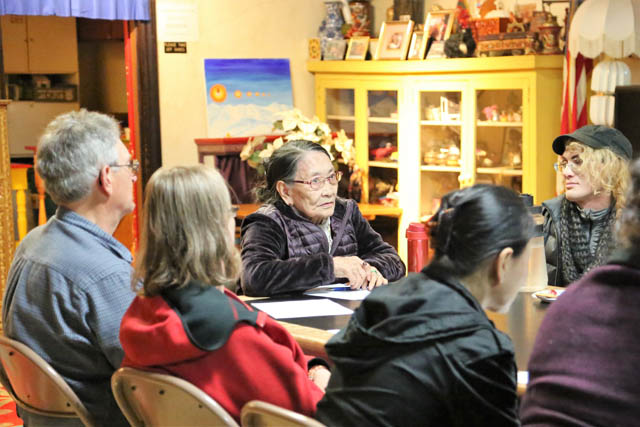
H.E. Dagyum Jusho ( Dagmola ) speaks to the group about the death process of animals from a Tibetan Buddhist perspective.
Photos by: Teresa Lamb, Zaya Vajra Sakya
An organization of Seattle Buddhists is offering a new expression of compassion, a program of hospice support for animals at the ends of their lives.
The program, called HOSTA (Hospice Support for Animals) was launched late in 2018 by members of the Marici Fellowship, the social outreach program at Sakya Monastery of Tibetan Buddhism in Seattle.
When our animal companions become sick and are approaching death, care givers are frequently left with feelings of loss, helplessness and confusion. In Western culture euthanasia is often the accepted way of dealing with this time in an animal’s life. The field of veterinary medicine is slowly adapting a more compassionate approach to the death of animals. Some doctors are even willing to come to the home, and even though there are some hospice options out there, the end result is usually euthanasia.
We wanted to offer another option, a program of support for those who choose to hospice their animals through the entire death process. We’re a group that understands the pain of losing an animal, and the anguish felt when they are suffering. We can support others by sharing stories of going through this process ourselves, and how we experienced the peace and calm surrounding the animal when it has completed this process naturally.

Most importantly the hope is to help others feel empowered, so they can care for their animals through the end of their lives with confidence and compassion. We want to help them find what is needed, and to feel supported during this time.
The next steps for HOSTA are to offer gatherings every few months or as often as needed, and to offer support for anyone interested. This support can include advice, spiritual support, medical support, or just an opportunity to talk.
We welcome any who are interested in attending a HOSTA gathering, whether you need support, or wish to offer support, ideas or skills. All are welcome and encouraged to come to our next meeting in March 2019, on a date to be determined.
We are presently creating a list of resources that will contain the advice in this article as well as more information including specific prayers and mantras to recite for our animals at the time of passing and when they are ill. This will be available at the Next HOSTA gathering in March 2019.
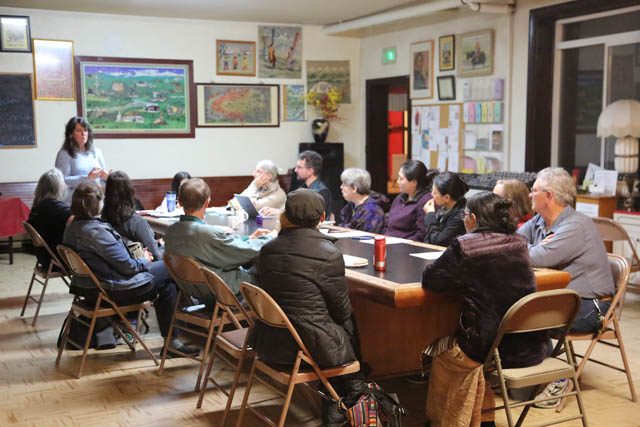
When we first met in the fall, we were honored to be joined by Her Eminence Dagyum Kusho Sakya. She was the wife of the founding lama of Sakya Monastery of Tibetan Buddhism, H.H. Jigdral Dagchen Sakya Dorje Chang (1924-2016), and is considered a spiritual teacher herself.
Dagmo Kusho (affectionately known as Dagmola to her students) gave us a glimpse into the spiritual beliefs around the death of animals in the Tibetan Buddhist tradition. Dagmola told us she has been around many animals at the end of their lives. She offered advice to follow at this time if you are a Buddhist.
She recommended that whoever is closest to the animal, the person who is their primary caregiver should be there at the time of death if at all possible. She suggested that they talk to their pets and say mantras at the time of death.
Ceremonies are similar to those offered humans, she said. For instance caregivers can put a blessing pill in an animal’s mouth as it is dying, and those pills may be available from the monks through this HOSTA group.
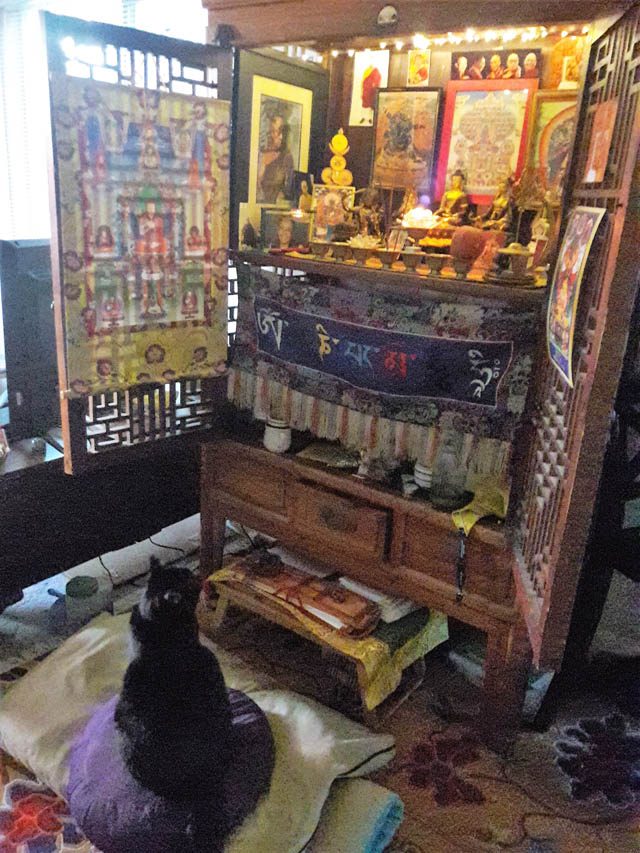
If you are Buddhist and your pet has died, have your animal cremated if possible, after leaving the body untouched for a minimum of 12 hours.
If you touch the animal, touch it only in the upper area of the body, particularly the top of the head. The belief is that the first place you touch an animal is where the consciousness will leave the body, and this can determine the animal’s future rebirth. If the consciousness leaves through the lower body this can cause rebirth in the lower realms, while leaving through the upper body causes rebirth in the higher realms.
You can scatter the animal’s ashes in holy places, or give them to someone traveling to pilgrimage sites. If you burying your animal, bury them covered with a khata (ceremonial offering scarf), and with mantras, prayers or pictures of Buddha. Be careful the burial spot is not a place people will walk over.
Ashes can be scattered in places where your animal was happiest, in the park, lake or mountains. If you are spreading ashes on your own property, you are free to do so. If you do so on private property belonging to someone else, be sure to ask permission.
It is legal to scatter ashes in a national or state park, but please check with a ranger and you may need to obtain a permit. Be sure to place the ashes away from trails or heavily used areas, to avoid the site being walked on. These are all recommendations and everyone’s situation is different, so please be kind to yourself if you are unable to do all the things mentioned above.
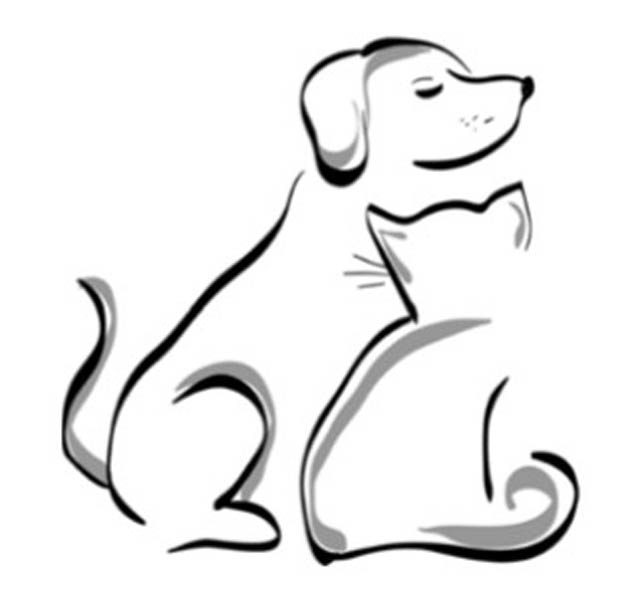
Experience behind HOSTA
Amy Alcaraz, one of the facilitators of this program, grew up on a dairy farm and spent her life caring for animals. She is a wildlife biologist as well as a licensed animal rehabilitator. She has seen the natural and not-so-natural death processes of many animals, including the passing of her own family animal companions.
Due to the newness of this program, the first meeting was an informational gathering and discussion. The 15 participants were asked about their own experiences, and why they were there that evening.
The reasons were varied. Some were looking for alternatives to euthanasia. Another, with a chronically ill cat whose end of life was imminent, was looking for suggestions on comfort care. A couple of people were struggling with difference of opinions within their household, about how the death process should go. Another person just wanted to prepare for when that time comes for their own animal.
Alcaraz offered information about the different needs of cats and dogs at this time. Cats tend to be more solitary, so it is important to keep the places they like to go available to them. Dogs view their family as their pack, so it is important to let them be near you if that seems to be what they want, although they may self-separate just prior to death.
Most important to keep in mind is the owner knows the pet best, so it is best to stay with them as much as possible.
Acupuncture is also finding its way into the animal kingdom, and can be as effective in managing animals’ pain as peoples’. A quick internet search can help you find an animal acupuncturist in your area.
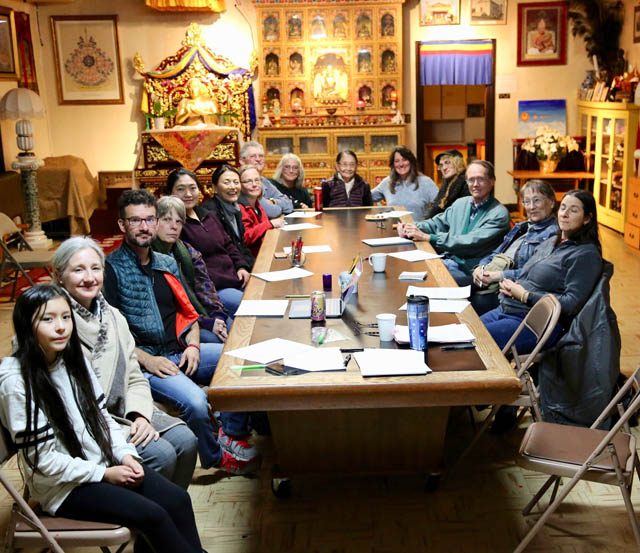
Ways HOSTA offers support
The purpose of this group is to offer outreach and to build a network of support, both medically and emotionally. To build this network we created a contact list and gathered information on how each of us can provide support, and what resources we can offer.
We welcome anyone who wants to lend a hand, be it holding an animal while it receives a treatment or simply doing prayers. One group member worked as a dog groomer for many years, and has offered help in grooming, nail trimming and overall care for an animal.
For those who are interested there is a form, (available on the HOSTA page on the Marici Fellowship website) which includes name, phone, email and neighborhood where you live, as well as what level of participation you are interested in.
Information is also available here about prayer vigils that can be offered, through the N.O.K (next of kin) end of life support group at Sakya Monastery.
In summary we had a wonderful time connecting around something that can be very painful, yet is something we all must face if we want to have animals in our lives. For more information please contact
Amy Alcaraz at hosta@marici-fellowship.org.
Teresa Lamb practices Tibetan Buddhism and has been an active member of Sakya Monastery of Tibetan Buddhism for 14 years. At the monastery she co-facilitates the community outreach program Marici Fellowship with Michael Lekas. She also serves as committee chair for the Virupa Educational Institute (VEI ) the educational arm of Sakya Monastery, and co- teaches The Teen Dharma Program.
